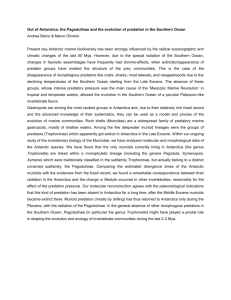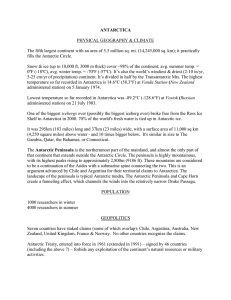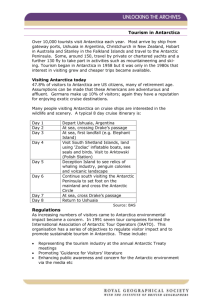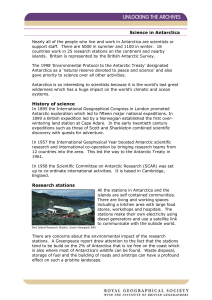Future Science Opportunities in Antarctica and the Southern Ocean RECOMMENDATIONS
advertisement
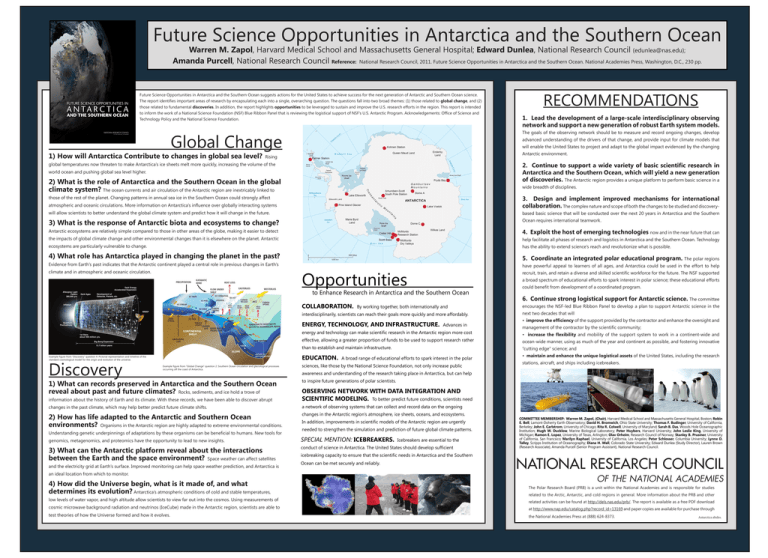
Future Science Opportunities in Antarctica and the Southern Ocean Warren M. Zapol, Harvard Medical School and Massachusetts General Hospital; Edward Dunlea, National Research Council (edunlea@nas.edu); Amanda Purcell, National Research Council Reference: National Research Council, 2011. Future Science Opportunities in Antarctica and the Southern Ocean. National Academies Press, Washington, D.C., 230 pp. Future Science Opportunities in Antarctica and the Southern Ocean suggests actions for the United States to achieve success for the next generation of Antarctic and Southern Ocean science. The report identifies important areas of research by encapsulating each into a single, overarching question. The questions fall into two broad themes: (1) those related to global change, and (2) those related to fundamental discoveries. In addition, the report highlights opportunities to be leveraged to sustain and improve the U.S. research efforts in the region. This report is intended to inform the work of a National Science Foundation (NSF) Blue Ribbon Panel that is reviewing the logistical support of NSF’s U.S. Antarctic Program. Acknowledgements: Office of Science and Technology Policy and the National Science Foundation. 1. Lead the development of a large-scale interdisciplinary observing network and support a new generation of robust Earth system models. The goals of the observing network should be to measure and record ongoing changes, develop Global Change 1) How will Antarctica Contribute to changes in global sea level? RECOMMENDATIONS advanced understanding of the drivers of that change, and provide input for climate models that will enable the United States to project and adapt to the global impact evidenced by the changing Antarctic environment. Rising 2. Continue to support a wide variety of basic scientific research in Antarctica and the Southern Ocean, which will yield a new generation of discoveries. The Antarctic region provides a unique platform to perform basic science in a global temperatures now threaten to make Antarctica’s ice sheets melt more quickly, increasing the volume of the world ocean and pushing global sea level higher. 2) What is the role of Antarctica and the Southern Ocean in the global climate system? The ocean currents and air circulation of the Antarctic region are inextricably linked to wide breadth of disciplines. atmospheric and oceanic circulations. More information on Antarctica’s influence over globally interacting systems 3. Design and implement improved mechanisms for international collaboration. The complex nature and scope of both the changes to be studied and discovery- will allow scientists to better understand the global climate system and predict how it will change in the future. based basic science that will be conducted over the next 20 years in Antarctica and the Southern 3) What is the response of Antarctic biota and ecosystems to change? Ocean requires international teamwork. Antarctic ecosystems are relatively simple compared to those in other areas of the globe, making it easier to detect 4. Exploit the host of emerging technologies now and in the near future that can those of the rest of the planet. Changing patterns in annual sea ice in the Southern Ocean could strongly affect the impacts of global climate change and other environmental changes than it is elsewhere on the planet. Antarctic help facilitate all phases of research and logistics in Antarctica and the Southern Ocean. Technology ecosystems are particularly vulnerable to change. has the ability to extend science’s reach and revolutionize what is possible. 4) What role has Antarctica played in changing the planet in the past? 5. Coordinate an integrated polar educational program. The polar regions Evidence from Earth’s past indicates that the Antarctic continent played a central role in previous changes in Earth’s have powerful appeal to learners of all ages, and Antarctica could be used in the effort to help Opportunities climate and in atmospheric and oceanic circulation. recruit, train, and retain a diverse and skilled scientific workforce for the future. The NSF supported a broad spectrum of educational efforts to spark interest in polar science; these educational efforts to Enhance Research in Antarctica and the Southern Ocean COLLABORATION. By working together, both internationally and interdisciplinarily, scientists can reach their goals more quickly and more affordably. ENERGY, TECHNOLOGY, AND INFRASTRUCTURE. Advances in energy and technology can make scientific research in the Antarctic region more cost effective, allowing a greater proportion of funds to be used to support research rather Example figure from “Discovery” question 4: Pictorial representation and timeline of the standard cosmological model for the origin and evolution of the universe. Discovery Example figure from “Global Change” question 2: Southern Ocean circulation and glaciological processes occurring off the coast of Antarctica. 1) What can records preserved in Antarctica and the Southern Ocean reveal about past and future climates? Rocks, sediments, and ice hold a trove of encourages the NSF-led Blue Ribbon Panel to develop a plan to support Antarctic science in the next two decades that will • improve the efficiency of the support provided by the contractor and enhance the oversight and management of the contractor by the scientific community; • increase the flexibility and mobility of the support system to work in a continent-wide and ocean-wide manner, using as much of the year and continent as possible, and fostering innovative “cutting edge” science; and EDUCATION. • maintain and enhance the unique logistical assets of the United States, including the research A broad range of educational efforts to spark interest in the polar sciences, like those by the National Science Foundation, not only increase public stations, aircraft, and ships including icebreakers. awareness and understanding of the research taking place in Antarctica, but can help to inspire future generations of polar scientists. information about the history of Earth and its climate. With these records, we have been able to discover abrupt changes in the past climate, which may help better predict future climate shifts. a network of observing systems that can collect and record data on the ongoing 2) How has life adapted to the Antarctic and Southern Ocean environments? Organisms in the Antarctic region are highly adapted to extreme environmental conditions. changes in the Antarctic region’s atmosphere, ice sheets, oceans, and ecosystems. In addition, improvements in scientific models of the Antarctic region are urgently needed to strengthen the simulation and prediction of future global climate patterns. genomics, metagenomics, and proteomics have the opportunity to lead to new insights. SPECIAL MENTION: ICEBREAKERS. 3) What can the Antarctic platform reveal about the interactions between the Earth and the space environment? Space weather can affect satellites conduct of science in Antarctica. The United States should develop sufficient and the electricity grid at Earth’s surface. Improved monitoring can help space weather prediction, and Antarctica is 6. Continue strong logistical support for Antarctic science. The committee than to establish and maintain infrastructure. OBSERVING NETWORK WITH DATA INTEGRATION AND SCIENTIFIC MODELING. To better predict future conditions, scientists need Understanding genetic underpinnings of adaptations by these organisms can be beneficial to humans. New tools for could benefit from development of a coordinated program. Icebreakers are essential to the COMMITTEE MEMBERSHIP: Warren M. Zapol, (Chair), Harvard Medical School and Massachusetts General Hospital, Boston; Robin E. Bell, Lamont-Doherty Earth Observatory; David H. Bromwich, Ohio State University; Thomas F. Budinger, University of California, Berkeley; John E. Carlstrom, University of Chicago; Rita R. Colwell, University of Maryland; Sarah B. Das, Woods Hole Oceanographic Institution; Hugh W. Ducklow, Marine Biological Laboratory; Peter Huybers, Harvard University; John Leslie King, University of Michigan; Ramon E. Lopez, University of Texas, Arlington; Olav Orheim, Research Council of Norway; Stanley B. Prusiner, University of California, San Francsico; Marilyn Raphael, University of California, Los Angeles; Peter Schlosser, Columbia University; Lynne D. Talley, Scripps Institution of Oceanography; Diana H. Wall, Colorado State University; Edward Dunlea (Study Director), Lauren Brown (Research Associate), Amanda Purcell (Senior Program Assistant), National Research Council. icebreaking capacity to ensure that the scientific needs in Antarctica and the Southern Ocean can be met securely and reliably. an ideal location from which to monitor. 4) How did the Universe begin, what is it made of, and what determines its evolution? Antarctica’s atmospheric conditions of cold and stable temperatures, low levels of water vapor, and high altitude allow scientists to view far out into the cosmos. Using measurements of cosmic microwave background radiation and neutrinos (IceCube) made in the Antarctic region, scientists are able to test theories of how the Universe formed and how it evolves. The Polar Research Board (PRB) is a unit within the National Academies and is responsible for studies related to the Arctic, Antarctic, and cold regions in general. More information about the PRB and other related activities can be found at http://dels.nas.edu/prb/. The report is available as a free PDF download at http://www.nap.edu/catalog.php?record_id=13169 and paper copies are available for purchase through the National Academies Press at (888) 624-8373. Antarctica abides.

